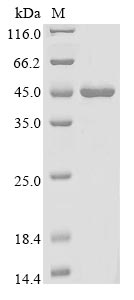Recombinant Paeniclostridium sordellii Sialidase gets expressed in a baculovirus system and covers the full length of the mature protein—specifically the 28-404 amino acid region. The protein carries an N-terminal 10xHis tag and a C-terminal Myc tag, which makes purification and detection much easier. It achieves a purity level greater than 90%, as verified by SDS-PAGE, making it suitable for research applications.
Sialidase from Paeniclostridium sordellii is an enzyme that cleaves sialic acid residues from glycoproteins and glycolipids. This activity appears to be essential in various biological processes, including cellular recognition, adhesion, and immune responses. Understanding how sialidases function and are regulated may provide insights into microbial pathogenicity and host-pathogen interactions. This makes the enzyme a valuable tool in microbiological and biochemical research.
Potential Applications
Note: The applications listed below are based on what we know about this protein's biological functions, published research, and experience from experts in the field. However, we haven't fully tested all of these applications ourselves yet. We'd recommend running some preliminary tests first to make sure they work for your specific research goals.
Paeniclostridium sordellii Sialidase is a bacterial enzyme that requires precise folding, proper active site formation, and specific tertiary structure for its functional activity in cleaving sialic acids. The baculovirus expression system provides a eukaryotic environment that supports proper folding, disulfide bond formation, and potential glycosylation, which is favorable for this protein. The dual N-terminal 10xHis-tag and C-terminal Myc-tag are relatively small (∼1 kDa and ∼1.2 kDa, respectively) compared to the protein size (377 aa, ∼40 kDa), minimizing steric interference. The full-length mature protein (28-404aa) contains all functional domains. The probability of correct folding with functional sialidase activity is high due to the expression system, but experimental validation of enzymatic activity is recommended to confirm bioactivity.
1. Biochemical Characterization of Bacterial Sialidase Activity
This application carries a moderate risk without functional validation. Sialidase activity requires precise active site formation and proper folding. If correctly folded and active (verified through enzymatic assays with sialylated substrates), the protein is suitable for kinetic studies (Km, Vmax) and substrate specificity assays. If misfolded/inactive (unverified), characterization data will be biologically meaningless.
2. Comparative Enzyme Studies Across Bacterial Species
Meaningful comparative studies require native enzyme conformation and functional activity. If correctly folded and active (verified), the protein enables valid evolutionary and functional comparisons with other sialidases. If misfolded/inactive (unverified), comparative analyses would yield misleading insights about enzyme conservation and divergence.
3. Antibody Development and Immunological Studies
This application is highly suitable as antibody development relies on antigenic sequence recognition rather than functional enzymatic activity. The full-length protein provides comprehensive epitope coverage for generating sialidase-specific antibodies. The high purity (>90%) ensures minimal contamination-related issues during immunization.
4. Protein-Protein Interaction Studies
This application requires proper folding validation. Sialidase interactions with substrates or partners require precise tertiary structure. If correctly folded (verified), the protein may identify physiological interaction partners; if misfolded/unverified, there is a risk of non-specific binding or tag-mediated artefacts.
5. Inhibitor Screening and Drug Discovery Research
This application carries a significant risk without functional validation. Inhibitor screening requires native enzyme conformation and catalytic activity. If correctly folded and active (verified), the protein is suitable for high-throughput screening; if misfolded/inactive (unverified), screening results will be unreliable for drug discovery.
Final Recommendation & Action Plan
The baculovirus-expressed sialidase with small dual tags has a high probability of correct folding due to the eukaryotic expression system. Begin with enzymatic activity validation using standard sialidase assays (e.g., with fluorogenic substrates like MU-Neu5Ac) to confirm specific activity before considering functional applications. Applications 1, 2, 4, and 5 require this validation. Application 3 (antibody development) can proceed immediately. For reliable sialidase research, validate kinetic parameters and substrate specificity, and include appropriate controls for tag interference in critical experiments.






